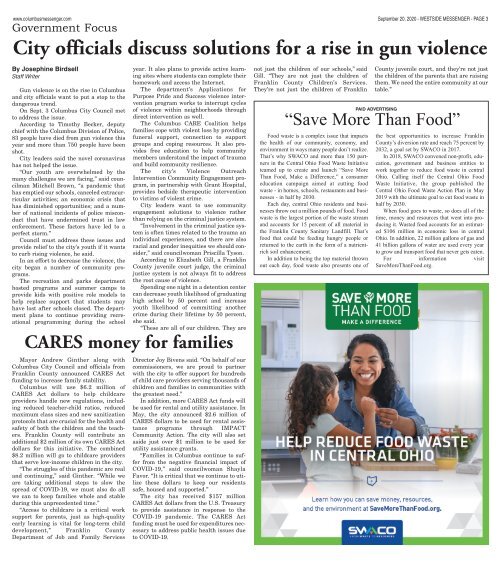You also want an ePaper? Increase the reach of your titles
YUMPU automatically turns print PDFs into web optimized ePapers that Google loves.
www.columbusmessenger.com<br />
By Josephine Birdsell<br />
Staff Writer<br />
Gun violence is on the rise in Columbus<br />
and city officials want to put a stop to the<br />
dangerous trend.<br />
On Sept. 3 Columbus City Council met<br />
to address the issue.<br />
According to Timothy Becker, deputy<br />
chief with the Columbus Division of Police,<br />
83 people have died from gun violence this<br />
year and more than 750 people have been<br />
shot.<br />
City leaders said the novel coronavirus<br />
has not helped the issue.<br />
“Our youth are overwhelmed by the<br />
many challenges we are facing,” said councilman<br />
Mitchell Brown, “a pandemic that<br />
has emptied our schools, canceled extracurricular<br />
activities; an economic crisis that<br />
has diminished opportunities; and a number<br />
of national incidents of police misconduct<br />
that have undermined trust in law<br />
enforcement. These factors have led to a<br />
perfect storm.”<br />
Council must address these issues and<br />
provide relief to the city’s youth if it wants<br />
to curb rising violence, he said.<br />
In an effort to decrease the violence, the<br />
city began a number of community programs.<br />
The recreation and parks department<br />
hosted programs and summer camps to<br />
provide kids with positive role models to<br />
help replace support that students may<br />
have lost after schools closed. The department<br />
plans to continue providing recreational<br />
programming during the school<br />
year. It also plans to provide active learning<br />
sites where students can complete their<br />
homework and access the Internet.<br />
The department’s Applications for<br />
Purpose Pride and Success violence intervention<br />
program works to interrupt cycles<br />
of violence within neighborhoods through<br />
direct intervention as well.<br />
The Columbus CARE Coalition helps<br />
families cope with violent loss by providing<br />
funeral support, connection to support<br />
groups and coping resources. It also provides<br />
free education to help community<br />
members understand the impact of trauma<br />
and build community resilience.<br />
The city’s Violence Outreach<br />
Intervention Community Engagement program,<br />
in partnership with Grant Hospital,<br />
provides bedside therapeutic intervention<br />
to victims of violent crime.<br />
City leaders want to use community<br />
engagement solutions to violence rather<br />
than relying on the criminal justice system.<br />
“Involvement in the criminal justice system<br />
is often times related to the trauma an<br />
individual experiences, and there are also<br />
racial and gender inequities we should consider,”<br />
said councilwoman Priscilla Tyson.<br />
According to Elizabeth Gill, a Franklin<br />
County juvenile court judge, the criminal<br />
justice system is not always fit to address<br />
the root cause of violence.<br />
Spending one night in a detention center<br />
can decrease youth likelihood of graduating<br />
high school by 50 percent and increase<br />
youth likelihood of committing another<br />
crime during their lifetime by 50 percent,<br />
she said.<br />
“These are all of our children. They are<br />
not just the children of our schools,” said<br />
Gill. “They are not just the children of<br />
Franklin County Children’s Services.<br />
They’re not just the children of Franklin<br />
<strong>September</strong> 20, <strong>2020</strong> - WESTSIDE MESSENGER - PAGE 3<br />
Government Focus<br />
City officials discuss solutions for a rise in gun violence<br />
CARES money for families<br />
Mayor Andrew Ginther along with<br />
Columbus City Council and officials from<br />
Franklin County announced CARES Act<br />
funding to increase family stability.<br />
Columbus will use $6.2 million of<br />
CARES Act dollars to help childcare<br />
providers handle new regulations, including<br />
reduced teacher-child ratios, reduced<br />
maximum class sizes and new sanitization<br />
protocols that are crucial for the health and<br />
safety of both the children and the teachers.<br />
Franklin County will contribute an<br />
additional $2 million of its own CARES Act<br />
dollars for this initiative. The combined<br />
$8.2 million will go to childcare providers<br />
that serve low-income children in the city.<br />
“The struggles of this pandemic are real<br />
and continuing,” said Ginther. “While we<br />
are taking additional steps to slow the<br />
spread of COVID-19, we must also do all<br />
we can to keep families whole and stable<br />
during this unprecedented time.”<br />
“Access to childcare is a critical work<br />
support for parents, just as high-quality<br />
early learning is vital for long-term child<br />
development,” Franklin County<br />
Department of Job and Family Services<br />
Director Joy Bivens said. “On behalf of our<br />
commissioners, we are proud to partner<br />
with the city to offer support for hundreds<br />
of child care providers serving thousands of<br />
children and families in communities with<br />
the greatest need.”<br />
In addition, more CARES Act funds will<br />
be used for rental and utility assistance. In<br />
May, the city announced $2.6 million of<br />
CARES dollars to be used for rental assistance<br />
programs through IMPACT<br />
Community Action. The city will also set<br />
aside just over $1 million to be used for<br />
utility assistance grants.<br />
“Families in Columbus continue to suffer<br />
from the negative financial impact of<br />
COVID-19,” said councilwoman Shayla<br />
Favor. “It is critical that we continue to utilize<br />
these dollars to keep our residents<br />
safe, housed and supported.”<br />
The city has received $157 million<br />
CARES Act dollars from the U.S. Treasury<br />
to provide assistance in response to the<br />
COVID-19 pandemic. The CARES Act<br />
funding must be used for expenditures necessary<br />
to address public health issues due<br />
to COVID-19.<br />
Food waste is a complex issue that impacts<br />
the health of our community, economy, and<br />
environment in ways many people don’t realize.<br />
That’s why SWACO and more than 150 partners<br />
in the Central Ohio Food Waste Initiative<br />
teamed up to create and launch “Save More<br />
Than Food, Make a Difference,” a consumer<br />
education campaign aimed at cutting food<br />
waste - in homes, schools, restaurants and businesses<br />
- in half by 2030.<br />
Each day, central Ohio residents and businesses<br />
throw out a million pounds of food. Food<br />
waste is the largest portion of the waste stream<br />
and accounts for 15 percent of all material in<br />
the Franklin County Sanitary Landfill. That’s<br />
food that could be feeding hungry people or<br />
returned to the earth in the form of a nutrientrich<br />
soil enhancement.<br />
In addition to being the top material thrown<br />
out each day, food waste also presents one of<br />
County juvenile court, and they’re not just<br />
the children of the parents that are raising<br />
them. We need the entire community at our<br />
table.”<br />
PAID ADVERTISING<br />
“Save More Than Food”<br />
the best opportunities to increase Franklin<br />
County’s diversion rate and reach 75 percent by<br />
2032, a goal set by SWACO in 2017.<br />
In 2018, SWACO convened non-profit, education,<br />
government and business entities to<br />
work together to reduce food waste in central<br />
Ohio. Calling itself the Central Ohio Food<br />
Waste Initiative, the group published the<br />
Central Ohio Food Waste Action Plan in May<br />
2019 with the ultimate goal to cut food waste in<br />
half by 2030.<br />
When food goes to waste, so does all of the<br />
time, money and resources that went into producing<br />
it. Wasted food accounts for an estimated<br />
$106 million in economic loss in central<br />
Ohio. In addition, 22 million gallons of gas and<br />
41 billion gallons of water are used every year<br />
to grow and transport food that never gets eaten.<br />
For information visit<br />
SaveMoreThanFood.org.


















